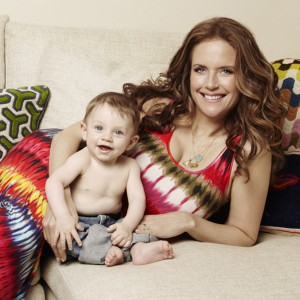
achieving their personal breastfeeding goals
Kelly Preston and “Extended” Breastfeeding
As someone who didn’t want to breastfeed past six months (and feared embarrassment), I can understand where some of the comments (230+ and counting!) are coming from with regards to Kelly Preston’s news that she is nursing 16-month old Benjamin (see PEOPLE.com-we shared it here last week, when we announced Kelly as a Best for Babes Champion for Moms).
What changed my mind about nursing past a few months was the fact that 1) breastfeeding after 6 months was SO easy and convenient, especially while traveling or running errands, and it seemed silly NOT to continue, and 2) my 2-year old daughter was the only one of her peers not to be hospitalized for dehydration during a nasty rotovirus outbreak; breastmilk was the only fluid she could keep down (not pedialyte or water).
While intuitively we sense that breastfeeding after a year is biologically and evolutionarily advantageous, we need more studies to bear that out (see this comment). In the meantime, the below was culled from Kellymom.com and other sources:
FACTS about breastfeeding after 1 year:
- After 1 year, human milk has significantly increased fat and energy contents, compared with human milk before 1 year. Babies’ brains are growing and NEED the extra fat & especially human cholesterol.
- In the second year (12-23 months), 448 mL of breastmilk provides (Dewey 2001): 29% of energy requirements, 43% of protein requirements,36% of calcium requirements,75% of vitamin A requirements,76% of folate requirements, 94% of vitamin B12 requirements, 60% of vitamin C requirements . Note that this is exactly what baby humans need; cow’s milk is designed to grow baby cows which have smaller brains per body mass.
- Nursing toddlers between the ages of 16 and 30 months have been found to have fewer illnesses and illnesses of shorter duration than their non-nursing peers (Gulick 1986). In other words, the longer that toddlers are allowed to nurse, the lower their risk of disease. There is also a proportionate increase in IQ for babies and toddlers who breastfeed longer, i.e. higher IQ for breastfeeding over 1 year vs. 6-12 months.
- Some of the immune factors in breastmilk increase in concentration during the second year and also during the weaning process. (Goldman 1983, Goldman & Goldblum 1983, Institute of Medicine 1991).
- In cultures where mothers and babies are not pressured to wean prematurely, babies self-wean naturally between 2.5 and 7 years of age, with most babies self-weaning around age 3 or 4. (Dettwyler)
- The longer babies are allowed to nurse the better socially adjusted they are. Per the researchers, ‘There are statistically significant tendencies for conduct disorder scores to decline with increasing duration of breastfeeding.’”
- Breastfeeding toddlers (babies > 1 year), helps them learn to self-soothe and self-regulate, manage frustrations (some parents report avoiding the “terrible twos” altogether) and lessens pain from bumps and bruises (breastmilk contains analgesics, i.e. natural pain-killers). Nursing toddlers are easier to handle in the doctor’s office, too!
- Breastfeeding toddlers (babies > 1 year) helps them make a gradual transition to childhood, “Meeting a child’s dependency needs is the key to helping that child achieve independence. And children outgrow these needs according to their own unique timetable.” Children who achieve independence at their own pace are more secure in that independence then children forced into independence prematurely.
- The longer mothers breastfeed, the lower their risk of breast cancer, ovarian cancer, uterine cancer, osteoporosis, rheumatoid arthritis, and heart disease.
- Older babies/toddlers nurse fewer times per day, most people are usually unaware they are nursing.
- Babies that are old enough to “ask” to nurse are also old enough to say “thank you”, one of the sweetest experiences any mother can experience!
So, truthfully, there is no such thing as “extended” breastfeeding or “still” breastfeeding much as there is no such thing as “extended” walking or “still” walking. Breastfeeding, like walking, is part of being human and begins and ends when it is evolutionary and developmentally advantageous. In the case of breastfeeding, that is birth to somewhere between 2.5 and 7, end of story. Anything other than that is premature weaning-and we all need to accept and acknowledge that.
Of course, may choose to wean early for various reasons (I did!), but we owe it to ourselves to acknowledge and OWN those reasons. Furthermore, nobody should be judged for weaning at any time, but listened to, UNDERSTOOD and accepted. Through this kind of supportive dialogue, mothers are more likely to breastfeed longer, and start to think about whether, if any, booby traps kept them from achieving their personal breastfeeding goals. No matter when a mother weans, every ounce, every day counts! Cheer moms on first, listen and seek to understand before you educate. Don’t leave an angry rant on a blog. ![]()
What made you decide to breastfeed longer than you intended? What have you done that has worked to encourage other moms to nurse longer than they intended?
Source URL: http://www.bestforbabes.org/kelly-preston-extended-breastfeeding
Note: This BestforBabes® document is for educational purposes only, is not intended to diagnose or treat any medical condition, and
is not a substitute for
an in-person evaluation by a physician trained in lactation management or an
International Board Certified Lactation Consultant (IBCLC).
2007-2011 The Best for Babes Foundation®. All rights reserved.
